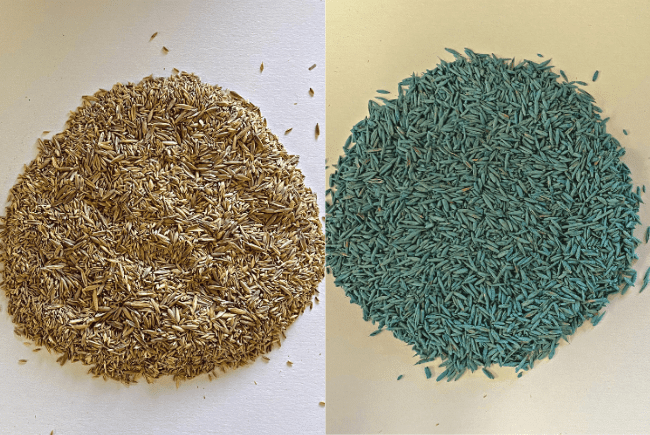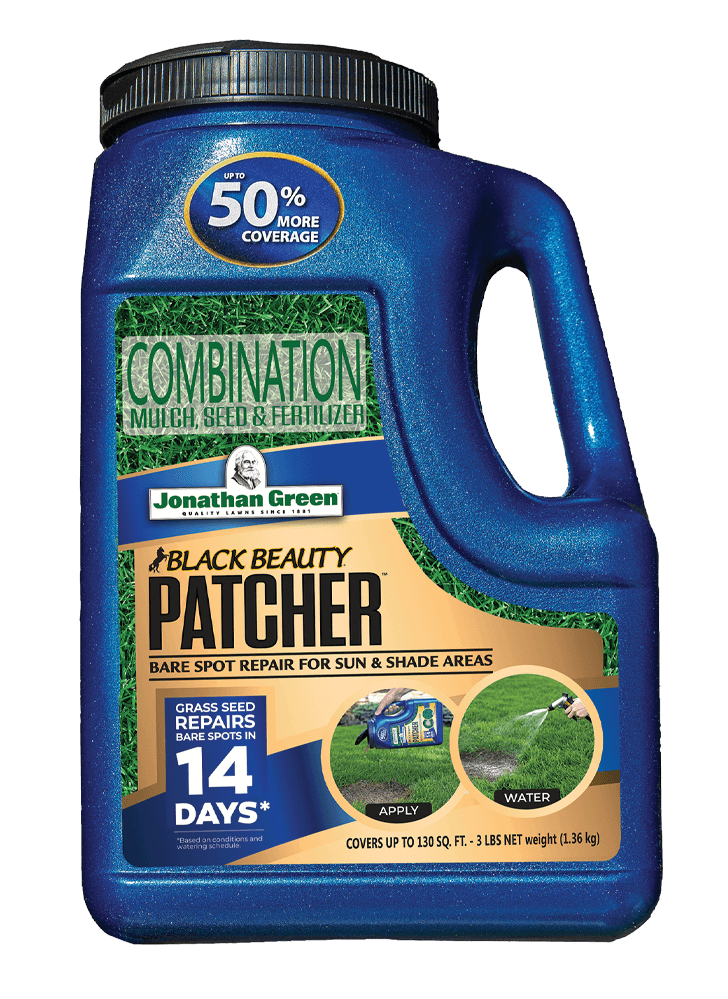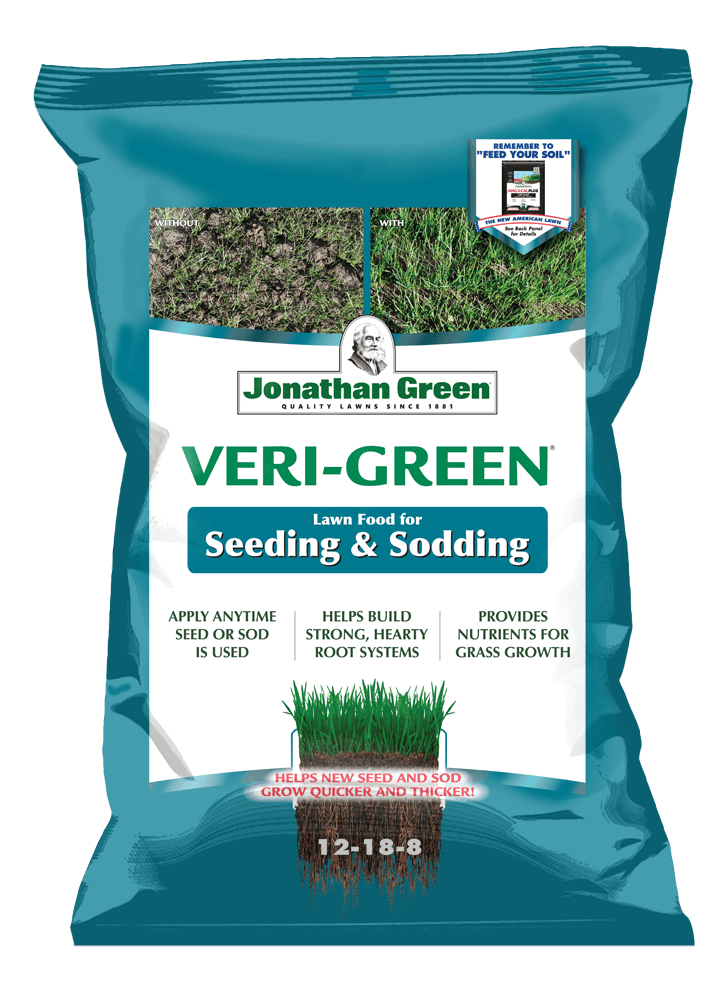How to Know the Difference Between Coated vs. Uncoated Grass Seed
When choosing the right grass seed for your lawn, you might find yourself overwhelmed by the many grass seed mixtures available. You may also notice the word “coated” or “coating technology” amongst your available options and wonder, “What exactly is coated grass seed?” and “Will it make a positive difference on my lawn?”
Here are the answers to the most common questions about coated and uncoated grass seed.
What is coated grass seed?
Coated grass seed refers to a protective coating made out of clay that is designed to aid in keeping the seed moist during the germination process. This coating can sometimes be dyed and will usually possess a blue or green color to help the user see how much they are applying to their lawn. Many brands add a fertilizer, fungicide, or insecticide to the clay coating to protect and feed the newly emerged seedlings.
What is the difference between coated and uncoated grass seed?

Coverage:
The coating on grass seed increases its weight and size, which means that it takes a smaller amount of coated seed to fill a bag. For example, when purchasing a 3-pound bag of coated grass seed mix, people often assume that they’re getting 3 pounds of seed. However, what they’re really getting is around 1.5 pounds of grass seed, with the rest of the weight coming from the coating material and inert matter.
To see for yourself, next time you are at the store check the coverage rates printed on the front of the grass seed mix bags.
Initially, this may not seem like a big deal but if you have a 1,000 square foot lawn the number of bags you’d need to purchase to newly seed your whole yard could increase significantly if the seed is coated.
In this example, if your lawn is 1,000 square feet, you would need only one 3-pound bag of Jonathan Green Black Beauty® Patcher Lawn Bare Spot Repair but you would need to purchase up to 3 of the other brands 3 lb bags of Sun and Shade seed mixtures to cover the same area. Since most coated and uncoated grass seed bags retail for similar prices, you end up having to pay nearly triple the cost when purchasing coated seed.
On smaller properties, the cost difference between coated and uncoated grass seed may seem small, however, on lawns exceeding 1,000 sq ft, the cost difference can really burn a hole in your pocket! This is why turf professionals such as sod growers, who need to purchase in bulk rarely buy coated seed.
Germination:
The material on coated grass seed is designed to keep the seed moist so that the seed is less likely to dry out during germination. If you’re worried you may not have enough time to water your newly seeded lawn multiple times a day, coated seed could be a good option for you.
Fertilization:
Clay coatings sometimes contain a small amount of fertilizer to promote growth. Applying a new seeding fertilizer is typically recommended when seeding a lawn. However, the amount of fertilizer in the coating is often so small that there is very little food for the plant and will be used by the new grass in a few days.
If you are looking to fertilize when newly seeding, choose a fertilizer with higher levels of phosphorus like Veri-Green Starter Fertilizer for Seeding & Sodding. Phosphorus is a key nutrient that helps in the development of root formation and fuels growth. New seeding fertilizers will contain twice the amount of phosphorus (the middle number on the analysis label), as nitrogen and potassium (the first and last numbers on the analysis label). This is called a 1-2-1 fertilizer formula.
For better results and a more cost-effective option, purchase and spread uncoated seed along with a new seeding fertilizer formula that contains higher levels of phosphorus.
Quality Control:
There is also an air of uncertainty with coated seed, as the coating and dye must be washed off before the seed mixture can be inspected for other contaminants such as weed seed, crop seed, and inert matter. In theory, the coating could be removed to determine what’s underneath, but in practice, this hardly ever happens.
Pure, uncoated grass seed gives you the peace of mind of knowing exactly the kind of high quality and type of grass seed you’re getting. You won’t have to wonder what kind of fillers, chemicals, or dyes are being used, as the uncoated seed is easier to test for contaminants.
Mentioned Products
What are the key factors in choosing grass seed?
To ensure you choose the correct type of grass seed for your lawn, you should consider the climate conditions, coverage amount, and most importantly, the quality. The first step in any grass seed selection process is determining your climate conditions. The cool-season grasses that Jonathan Green offers thrive best in the northern half of the United States.
Another key factor to consider when selecting grass seed is the amount of coverage you’ll need. You want to make sure you buy the right amount of seed to cover your entire lawn. This is where seed coating becomes important, as it is cheaper to buy natural, uncoated seed and get up to three times the amount of coverage.
The most important factor to always remember when choosing grass seed is the quality! The quality of the seed you’re getting matters more than if the seed is coated or uncoated, as it will inevitably be the foundation to a healthy lawn that will last for years to come.
You will find comfort in knowing that Jonathan Green grass seed has been carefully researched and bred over many years from genetically superior parental plants that have been proven to withstand heat, drought, disease, and insects. Jonathan Green grass seed mixtures have also been the top choice for turfgrass professionals like sod growers due to its natural dark green color and ability to withstand times of stress.
Should I buy coated grass seed?

Determining if buying coated grass seed is right for you all depends on your particular lawn care needs. Coated seed offers a small benefit of keeping the seed moist, but ultimately has little quality assurance and provides nearly half the amount of coverage as uncoated seed. Uncoated grass seed gives you 100% of the desired quantity and allows for quality control.
Conclusion
We hope that this article will help you to make an informed decision that will benefit the health of your lawn. Knowing all of the facts, including what coated grass is made of, how it differs from uncoated grass seed, and how this factors into selecting the perfect seed, will help you stay informed and pick the seed mixture that’s right for you!

